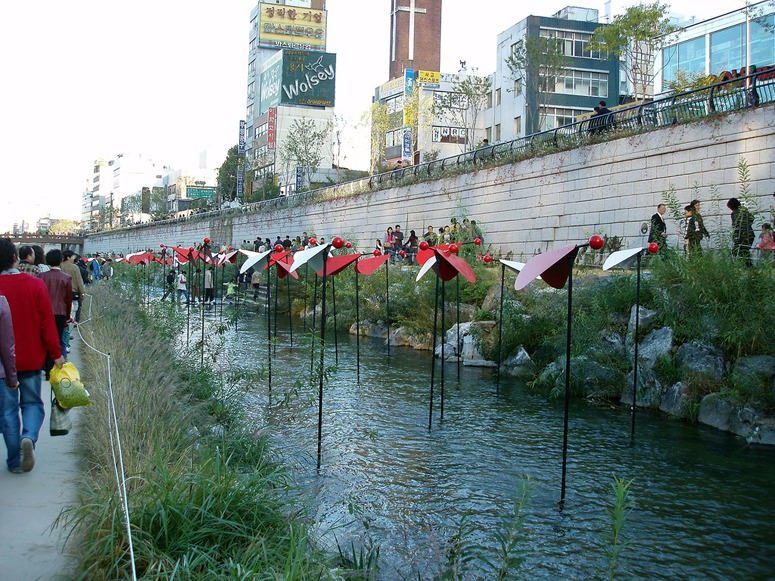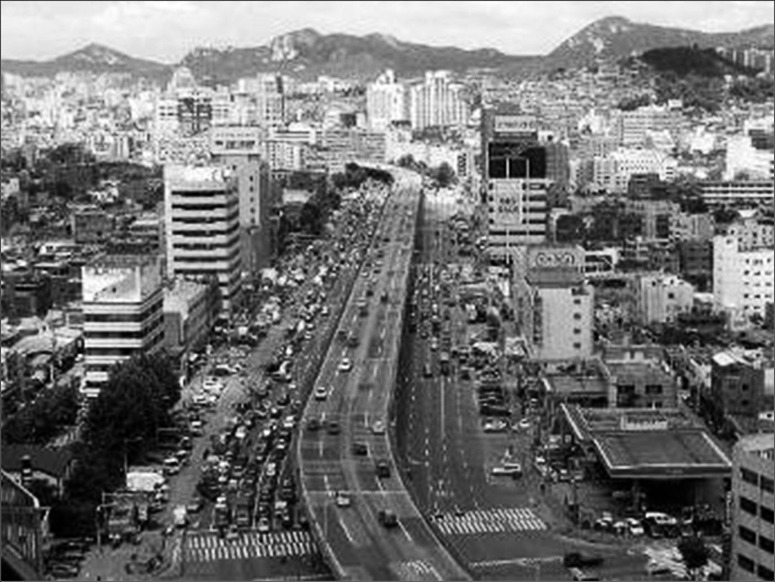
Brilliant landscape planning, and dreary landscape architecture, for the Cheonggyecheon River in Seoul, Korea
Korea has implemented a brilliantly ambitious and life-enhancing river restoration project which, unfortunately, is no masterpiece for Korean landscape architecture or garden design. Seoul, formerly Hanyang became Korea’s capital city in 1394 and a new city was built beside the lovely Cheonggyecheon River. Floods arrived from time to time but King Taejong (1400-1418) believed that nature should be allowed to run its course. A great stone bridge was built and the valley became a resort, a laundry, a children’s playground, a place for lantern festivals – and a sewer. During the Japanese occupation (1910-1945) the river was ‘improved’ in the sense of being dredged to protect the occupier’s property. Korean engineers decided the river should be buried and by 1967 it had disappeared from view. Construction of the Cheonggye Elevated Highway began in 1967 and was completed in 1976. It was built above the buried river. An elevated highway was then built above the valley It took 20 years to complete the project. The highway, 50-80m wide and 6km long, was opened in 1984. So far – so awful. But for the great good fortune of the Seoul’s citizens, the engineers were lousey and the steel beams began to rot. A report from the Korean Society of Civil Engineering, in 1992, recommended repairs. The programme of repairs went on for a decade but was innefective.
It was for this reason that the Cheonggyecheon Restoration Project was formulated. Engineers promised to transform Seoul’s grey concrete image. Their professed goal was “a lush, green city where clear waters flow. Through this and other such projects, Seoul will be re-born as a human-oriented environmental city, greatly increasing Seoul’s ‘brand’ value.” Tragically, the project was run by engineers and architects, with some planting, fountains, exterior lighting and ‘works of art’ stuffed in at the last minute. The result can be classed as brilliant landscape planning with crap landscape architecture. It is a terrible wind corridor and looks like the defensive ditch outside a walled Chinese city. Next time, they should make landscape architects the project co-ordinators.
I wish the UK had a river restoration project which was half as good as the Cheonggyecheon project – restoration of the River Fleet would be a good start. But the Koreans do seem to have learned something from the UK. Just as the Dunkirk disaster of June 1940 was proclaimed a victory, so the Cheonggyecheon disaster (photo below) is being presented as a triumph. Both boasts did some good and Seol has been nominated as the World Design Capital for 2010, partly on account of the Cheonggyecheon river reclamation. Still, I don’t think they read my chapter on River engineering, channelization and floods


First of all ‘Cheong-gye’ is the name of place, ‘cheon’ means stream. so you can call ‘Cheonggyechun’ or ‘cheonggye’ stream. Basically Cheonggyecheon is a stream that dries up spells of dry weather, a dry stream. This is the first ecological character of Cheonggyecheon when it was before period of Japanese occupation.
From the Japanese occupation (1910-1945) Cheongyechun became a dirty drain which shaped like ‘ㅁ’ . The water completely could not flow naturally.
Now, for me and most of landscape architects in Korea does not think that Choenggyechen is a real reclamation. Actually that project was a one of the biggest election pledge when Lee Myung-bak(previous Mayor of Seoul, now South Korea President) was candidate. Architects had to make the project until Lee finish his duty of Mayor of Seoul. Government use a lot of tax for pumping the water from Han River( which is main Water line in Seoul) to Chonggyechun. So far so bad only the slogan is “green sustainable Seoul’ , honestly Cheongyecheon is the masterpiece of Lee, not Seoul`s.
Thank you for the information. I must say that I notice a difference between the ‘official’ photographs of Cheonggyecheon, many of which look wonderful, and the general run of photographs on the web (eg on Flickr) which, unless taken after dark, look disappointing.
Interesting article. I’m looking for an old picture of the highway before the restoration. Could I ask where you found the b/w picture above?